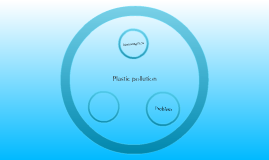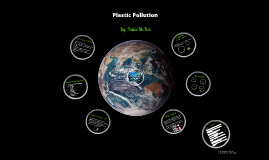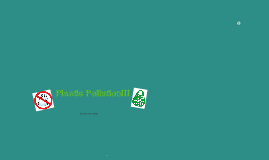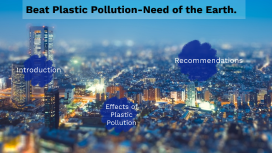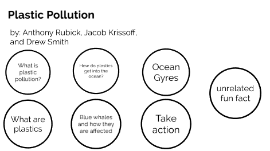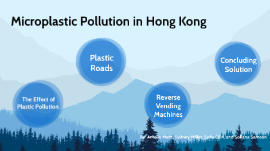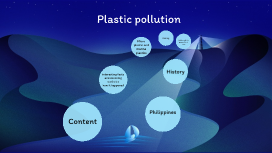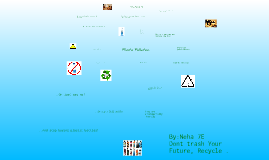Plastic Pollution
Transcript: Solving Our Plastic Problem Is created when styrofoam, meat trays, egg containers, and other deli containers are burned. In gas form it can be easily absorbed through the skin and lungs. long term exposure can damage the central nervous system causing symptoms such as depression, headache, fatigue, and weakness, and can cause minor effects on kidney function and blood. BPA Styrene Dioxins Type 1 plastic: Soft drink, water and beer bottles; mouthwash bottles; peanut butter containers; salad dressing bottles Recycled into: Polar fleece, fiber, tote bags, furniture, carpet, paneling Type 2 plastic: Milk jugs, juice bottles; bleach, detergent and household cleaner bottles; shampoo bottles; some trash and shopping bags; motor oil bottles; butter and yogurt tubs; cereal box liners Recycled into: Laundry detergent bottles, oil bottles, pens, recycling containers, floor tile, drainage pipe, lumber, benches, fencing Piping & plumbing fixtures Sinks, shower screen, bath tubs Counter-tops Flooring (vinyl) Paint, adhesives, sealants Lighting covers Insulation material Car bumpers Headlamp and tail lights covers, and reflectorsDashboard, buttons, instrument panelsInterior trimCar seatsSpeakers and audio devicesTruck bed linersPetrol tank and other lubricant tanksEngine parts MBA polymers has created a way to recycle every type of plastic. The Great Pacific Garbage Patch photo credit Nasa / Goddard Space Flight Center / Reto Stöckli Polychlorinated Biphenyls Plastic Pollution TED.com - http://www.ted.com/talks/lang/en/mike_biddle.html How plastics are made - http://www.reachoutmichigan.org/funexperiments/quick/plastic.html Dangerous Effect of Burning Plastic - http://www.wecf.eu/cms/download/2004-2005/homeburning_plastics.pdf What are plastics used for? - http://www.whatisplastic.com/?p=114 Exporting trash - http://www.cbsnews.com/8301-18560_162-4579229.html Health effects of PCBs - http://www.epa.gov/osw/hazard/tsd/pcbs/pubs/effects.htm Health effects of Bisphenol A - http://environment.about.com/od/healthenvironment/f/bisphenol-a-health-effects.htm Health effects of Dioxin - http://cfpub.epa.gov/ncea/CFM/nceaQFind.cfm?keyword=Dioxin Kitchen Utensils – ladles, spatula, spoons, knives, forks, chop sticksCups, plates, bowlsFood storage containersTrash cans, pails, buckets, tanksFurniture – plastic chairs, tables, cabinets Ways to Recycle Plastic The Waste They use a process called above-ground mining to collect the plastic. Then the plastic is sorted into different grades. The plastic is ground down, melted, formed into strings, and then cut into small pellets. This chemical leaches from plastic when exposed to high temperatures, such as a microwave or a dish washer. It has been linked to an increase in heart disease, diabetes and liver abnormalities in adults. Brain and hormone development problems in fetuses and young children. Other tests have shown that it can promote human breast cancer cell growth. Food Wrappers Tupperware Shampoo Laundry Detergent Cleaning Supplies Water bottles Soda and Juice bottles Shopping bags Cosmetic boxes The plastic disintegrates into smaller pieces but never fully breaks down. The smallest particles are ingested by oceanic wildlife, causing plastic to enter the food chain Resources Is released when plastic starts to decompose. Causes cancer, damage to the immune system, reproductive system, nervous system, and endocrine system. Computer monitor casing, keyboard & mouse, printer casing & ink cartridges Cables and wire coatings, connectors, plugs, socketsCasing and components for TV, DVD players, MP3 players, stereos setsCassette, tapes, CDs, DVDsWashing machines, refrigerators, air-conditioners, dishwashers Circuit boards The Pollutants Plastics are used in many different applications: Packaging Textile Medical Electronics Recreation Construction Home and Kitchen Automotive TBBA, PBB, PBDC Jackets Umbrellas Carpets Fabric for furniture and draperies Nylon stockings Luggage http://www.ted.com/talks/mike_biddle.html Caused by north and south currents combining carrying trash from land and waste from ships The organic materials biodegrade leaving plastic Blood bags Dental fillings, bridges, temporary crownsEyeglass frames and lensesToothbrush, toothpaste tubes, combs Disposable surgical gowns, gloves, masksHip joint replacement partsX-ray tables Artificial legs, feet and armsArtificial organs Syringes PCB All Krogers accepts blastic bags. Make sure to recycle electronics, they have plastic surrounding the metal parts The Murfreesboro recycling center only accepts type 1 and 2 plastics. Are a group of toxic chemical compounds that are released into the air when burned. The chemicals are deposited on land or in water and build up over time. They accumulate in our body fat and can be passed down through breast feeding. In nature, effects associated with these pollutants includes cancer, deformed offspring, reproductive failure, immune diseases and subtle neurobehavioral effects. Humans can be






